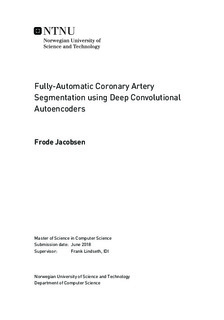Fully-Automatic Coronary Artery Segmentation using Deep Convolutional Autoencoders
Master thesis
Permanent lenke
http://hdl.handle.net/11250/2566501Utgivelsesdato
2018Metadata
Vis full innførselSamlinger
Sammendrag
Automatic semantic segmentation of medical images is an important tool in aiding clinical experts in diagnosing diseases. The large volume of data produced in medical imaging modalities such as CT and MRI, and the inherent problem of working with volumetric data on a two-dimensional screen, makes manual or semi-automatic segmentation a time-consuming affair. This thesis explores the application of deep convolutional autoencoders to volumetric medical image segmentation. Three different convolutional autoencoder architectures are trained to perform binary and multi-class coronary artery segmentation, as well as liver and liver vessel segmentation.
Coronary artery disease is a leading cause of death in the world, and diagnosis requires invasive methods. Reasearch has been done on using computational fluid dynamics in order to simulate blood flow in the coronary arteries based on non-invasive medical imaging modalities. Fully-automatic extraction of precise geometry of the coronary arteries from coronary CT angiography could lead to computational fractional flow-reserve measurements becoming a viable alternative to the current gold standard of invasive FFR measurements. The neural networks are trained on a dataset provided by the St. Olavs Hospital FFR project. This dataset consists of manual segmentations of coronary CT angiography, and is still in development. The proposed methods are able to produce segmentations of coronary arteries of a high quality. Two of the models is also able to produce reasonable voxel-wise multi-class segmentations, correctly segmenting the right and left coronary branches, as well as the aorta in most of the validation images.
Additional validation is performed on the 3D-IRCADb-01 dataset from IRCAD. It consists of CT images of the abdomen, with labels for most major organs and structures. The networks are able to learn to segment the complex vessel networks in the liver, as well as the liver itself, from a small dataset. The liver vessel segmentations contain some spurious responses, but still show that 2D convolutional autoencoders are viable for segmenting volumetric image data.
